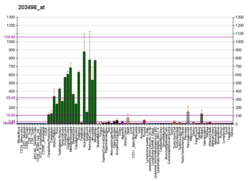RCAN2
Protein-coding gene in the species Homo sapiens
| RCAN2 | |||||||||||||||||||||||||||||||||||||||||||||||||||
|---|---|---|---|---|---|---|---|---|---|---|---|---|---|---|---|---|---|---|---|---|---|---|---|---|---|---|---|---|---|---|---|---|---|---|---|---|---|---|---|---|---|---|---|---|---|---|---|---|---|---|---|
| Identifiers | |||||||||||||||||||||||||||||||||||||||||||||||||||
| Aliases | RCAN2, CSP2, DSCR1L1, MCIP2, RCN2, ZAKI-4, ZAKI4, regulator of calcineurin 2 | ||||||||||||||||||||||||||||||||||||||||||||||||||
| External IDs | OMIM: 604876; MGI: 1858219; HomoloGene: 130985; GeneCards: RCAN2; OMA:RCAN2 - orthologs | ||||||||||||||||||||||||||||||||||||||||||||||||||
| |||||||||||||||||||||||||||||||||||||||||||||||||||
| |||||||||||||||||||||||||||||||||||||||||||||||||||
| |||||||||||||||||||||||||||||||||||||||||||||||||||
| |||||||||||||||||||||||||||||||||||||||||||||||||||
| |||||||||||||||||||||||||||||||||||||||||||||||||||
| Wikidata | |||||||||||||||||||||||||||||||||||||||||||||||||||
| |||||||||||||||||||||||||||||||||||||||||||||||||||
RCAN2 is a gene that in humans encodes for the protein Calcipressin-2.
Calcipressin-2 is a protein that in humans is encoded by the RCAN2 gene.[5][6]
Summary box
N/A
See also
References
- ^ a b c GRCh38: Ensembl release 89: ENSG00000172348 – Ensembl, May 2017
- ^ a b c GRCm38: Ensembl release 89: ENSMUSG00000039601 – Ensembl, May 2017
- ^ "Human PubMed Reference:". National Center for Biotechnology Information, U.S. National Library of Medicine.
- ^ "Mouse PubMed Reference:". National Center for Biotechnology Information, U.S. National Library of Medicine.
- ^ Miyazaki T, Kanou Y, Murata Y, Ohmori S, Niwa T, Maeda K, Yamamura H, Seo H (Aug 1996). "Molecular cloning of a novel thyroid hormone-responsive gene, ZAKI-4, in human skin fibroblasts". J Biol Chem. 271 (24): 14567–71. doi:10.1074/jbc.271.24.14567. PMID 8662924.
- ^ "Entrez Gene: DSCR1L1 Down syndrome critical region gene 1-like 1".
Further reading
- Bonaldo MF, Lennon G, Soares MB (1997). "Normalization and subtraction: two approaches to facilitate gene discovery". Genome Res. 6 (9): 791–806. doi:10.1101/gr.6.9.791. PMID 8889548.
- Rothermel B, Vega RB, Yang J, et al. (2000). "A protein encoded within the Down syndrome critical region is enriched in striated muscles and inhibits calcineurin signaling". J. Biol. Chem. 275 (12): 8719–25. doi:10.1074/jbc.275.12.8719. PMID 10722714.
- Strippoli P, Lenzi L, Petrini M, et al. (2000). "A new gene family including DSCR1 (Down Syndrome Candidate Region 1) and ZAKI-4: characterization from yeast to human and identification of DSCR1-like 2, a novel human member (DSCR1L2)". Genomics. 64 (3): 252–63. doi:10.1006/geno.2000.6127. PMID 10756093.
- Fuentes JJ, Genescà L, Kingsbury TJ, et al. (2000). "DSCR1, overexpressed in Down syndrome, is an inhibitor of calcineurin-mediated signaling pathways". Hum. Mol. Genet. 9 (11): 1681–90. doi:10.1093/hmg/9.11.1681. PMID 10861295.
- Cao X, Kambe F, Miyazaki T, et al. (2002). "Novel human ZAKI-4 isoforms: hormonal and tissue-specific regulation and function as calcineurin inhibitors". Biochem. J. 367 (Pt 2): 459–66. doi:10.1042/BJ20011797. PMC 1222895. PMID 12102656.
- Strausberg RL, Feingold EA, Grouse LH, et al. (2003). "Generation and initial analysis of more than 15,000 full-length human and mouse cDNA sequences". Proc. Natl. Acad. Sci. U.S.A. 99 (26): 16899–903. Bibcode:2002PNAS...9916899M. doi:10.1073/pnas.242603899. PMC 139241. PMID 12477932.
- Ota T, Suzuki Y, Nishikawa T, et al. (2004). "Complete sequencing and characterization of 21,243 full-length human cDNAs". Nat. Genet. 36 (1): 40–5. doi:10.1038/ng1285. PMID 14702039.
- Kimura K, Wakamatsu A, Suzuki Y, et al. (2006). "Diversification of transcriptional modulation: Large-scale identification and characterization of putative alternative promoters of human genes". Genome Res. 16 (1): 55–65. doi:10.1101/gr.4039406. PMC 1356129. PMID 16344560.
- Qin L, Zhao D, Liu X, et al. (2007). "Down syndrome candidate region 1 isoform 1 mediates angiogenesis through the calcineurin-NFAT pathway". Mol. Cancer Res. 4 (11): 811–20. doi:10.1158/1541-7786.MCR-06-0126. PMID 17114339.
- Gollogly LK, Ryeom SW, Yoon SS (2007). "Down syndrome candidate region 1-like 1 (DSCR1-L1) mimics the inhibitory effects of DSCR1 on calcineurin signaling in endothelial cells and inhibits angiogenesis". J. Surg. Res. 142 (1): 129–36. doi:10.1016/j.jss.2006.10.011. PMC 1995402. PMID 17610901.
External links
- RCAN2 human gene location in the UCSC Genome Browser.
- RCAN2 human gene details in the UCSC Genome Browser.
- v
- t
- e

















